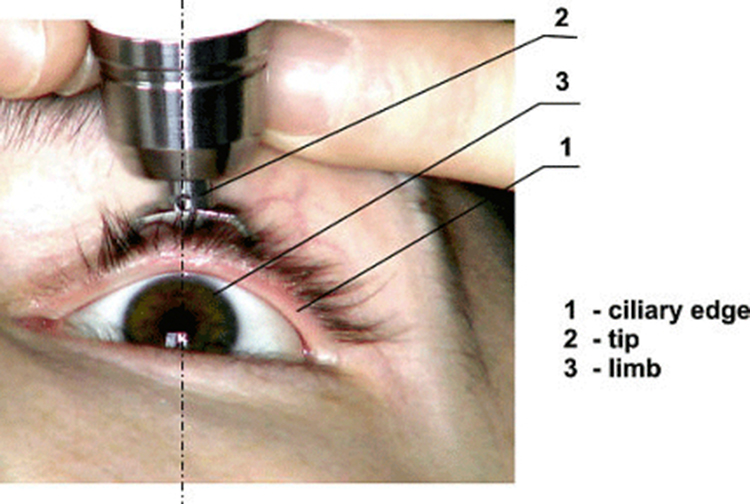| << Chapter < Page | Chapter >> Page > |
This force is the weight of about a 680-g mass. A mass of 680 g resting on the eye (imagine 1.5 lb resting on your eye) would be sufficient to cause it damage. (A normal force here would be the weight of about 120 g, less than one-quarter of our initial value.)
People over 40 years of age are at greatest risk of developing glaucoma and should have their intraocular pressure tested routinely. Most measurements involve exerting a force on the (anesthetized) eye over some area (a pressure) and observing the eye’s response. A noncontact approach uses a puff of air and a measurement is made of the force needed to indent the eye ( [link] ). If the intraocular pressure is high, the eye will deform less and rebound more vigorously than normal. Excessive intraocular pressures can be detected reliably and sometimes controlled effectively.

Suppose a 3.00-N force can rupture an eardrum. (a) If the eardrum has an area of , calculate the maximum tolerable gauge pressure on the eardrum in newtons per meter squared and convert it to millimeters of mercury. (b) At what depth in freshwater would this person’s eardrum rupture, assuming the gauge pressure in the middle ear is zero?
Strategy for (a)
The pressure can be found directly from its definition since we know the force and area. We are looking for the gauge pressure.
Solution for (a)
We now need to convert this to units of mm Hg:
Strategy for (b)
Here we will use the fact that the water pressure varies linearly with depth below the surface.
Solution for (b)
and therefore . Using the value above for , we have
Discussion
Similarly, increased pressure exerted upon the eardrum from the middle ear can arise when an infection causes a fluid buildup.
The pressure inside the lungs increases and decreases with each breath. The pressure drops to below atmospheric pressure (negative gauge pressure) when you inhale, causing air to flow into the lungs. It increases above atmospheric pressure (positive gauge pressure) when you exhale, forcing air out.
Lung pressure is controlled by several mechanisms. Muscle action in the diaphragm and rib cage is necessary for inhalation; this muscle action increases the volume of the lungs thereby reducing the pressure within them [link] . Surface tension in the alveoli creates a positive pressure opposing inhalation. (See Cohesion and Adhesion in Liquids: Surface Tension and Capillary Action .) You can exhale without muscle action by letting surface tension in the alveoli create its own positive pressure. Muscle action can add to this positive pressure to produce forced exhalation, such as when you blow up a balloon, blow out a candle, or cough.
The lungs, in fact, would collapse due to the surface tension in the alveoli, if they were not attached to the inside of the chest wall by liquid adhesion. The gauge pressure in the liquid attaching the lungs to the inside of the chest wall is thus negative, ranging from to during exhalation and inhalation, respectively. If air is allowed to enter the chest cavity, it breaks the attachment, and one or both lungs may collapse. Suction is applied to the chest cavity of surgery patients and trauma victims to reestablish negative pressure and inflate the lungs.

Notification Switch
Would you like to follow the 'College physics' conversation and receive update notifications?